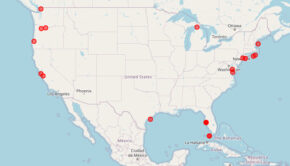High Tide Flooding and Annual Outlook
Published on October 1st, 2020
High-tide flooding, often referred to as “nuisance” or “sunny day” flooding, is increasingly common due to years of relative sea level increases. It occurs when tides reach anywhere from 1.75 to 2 feet above the daily average high tide and start spilling onto streets or bubbling up from storm drains.
As sea level rise continues, damaging floods that decades ago happened only during a storm now happen more regularly, such as during a full-moon tide or with a change in prevailing winds or currents.
Each year, the National Oceanic and Atmospheric Administration (NOAA) documents changes in high-tide flooding patterns from the previous year at 98 NOAA tide gauges along the U.S. coast, and provides a flooding outlook for these locations for the coming year, as well as projections for the next several decades.
The State of High Tide Flooding in 2019 and the Outlook through April 2021
Coastal communities across the U.S. continued to see record-setting high-tide flooding in 2019, forcing their residents and visitors to deal with flooded shorelines, streets and basements — a trend that is expected to continue into 2021.
• In 2019, the national annual flood frequency reached 4 days (median value), just shy of the record of 5 days set in 2018. High tide flooding is now accelerating at 75% of locations along the East and Gulf Coasts. Nineteen locations, primarily in these regions, broke or tied their flood records.
• Through May 2021, the national high tide flood frequency is expected to accelerate, with U.S. coastal communities seeing an average of 2 to 6 days of flooding in the coming year. Communities along the northeast and western Gulf coasts will see higher levels. No HTF is predicted for the U.S. Island coastlines.
• By 2030, high tide flooding is likely to be in the range of 7 – 15 days and by 2050, between 25 – 75 days. These long term outlooks are based on the range of relative sea level rise ‘more likely’ to occur by 2030 and 2050 using projections of the Fourth National Climate Assessment.
Full report… click here.









 We’ll keep your information safe.
We’ll keep your information safe.